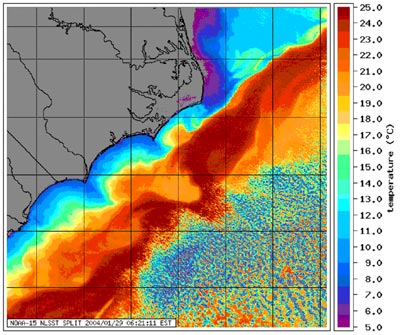 |
|
 |
 |
 |
 |
Figure 1- A surface thermal image from
Jan. 29, 2004, showing a sharp thermal front near Cape Hatteras
over the continental shelf. It is in close proximity to the
Gulf Stream. Note also the upwelled water near the Carolina
capes which is transported offshore, as well as the Gulf Stream
meanders south of Cape Hatteras. Click here
to see an animated satellite loop from December 6, 2002 to January 20, 2003 (note that this animated GIF
is ~1.9MB in size). |
Overview - Background
Where Currents Collide: Frontal Structure
and Marine Mammal Distributions in the Cape Hatteras Region
Brief Outline
Our scientific team will be performing
two intensive surveys during August, 2004 and January/February, 2005
to investigate frontal structures in the vicinity of Cape Hatteras
and the distribution of marine mammals relative to the fronts.
Scientific Background
The Cape Hatteras region is an important area oceanographically. It is the area in which the Gulf Stream separates from the continental slope to the deep ocean, and where southward flowing continental shelf water from the Middle Atlantic Bight converges with northward flowing continental shelf water from the South Atlantic Bight. During winter, a strong surface thermal front forms (Figure 1), which may act to aggregate marine mammals such as the Bottle-nosed dolphin.
Approach
We will be using two ships in August, 2004, one operating north of Cape Hatteras and one south of Cape Hatteras. Both ships will be towing instruments to obtain high-resolution data on the temperature, salinity, and current distributions in the area as they change over a two week period. Marine mammal observers will be on board to correlate mammal sightings with oceanographic structure. In January/February, 2005, we will also have a concurrent aerial survey of marine mammals as well as a third ship present sampling larval fish.
To read the full proposal (PDF format), click here.
This project is funded by the National Science Foundation.
|
 |
|



